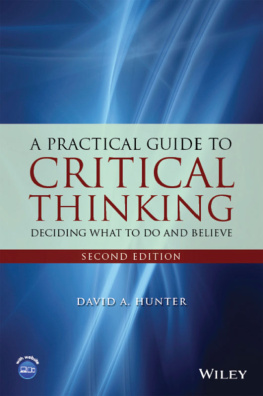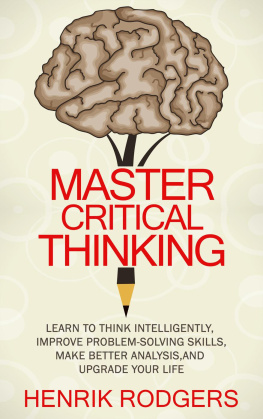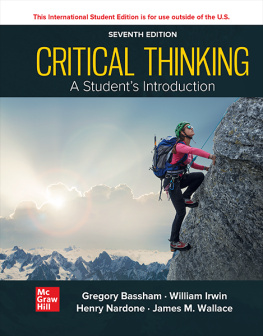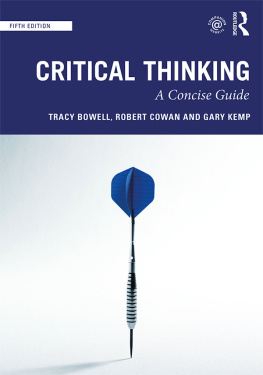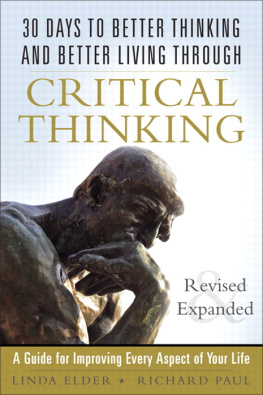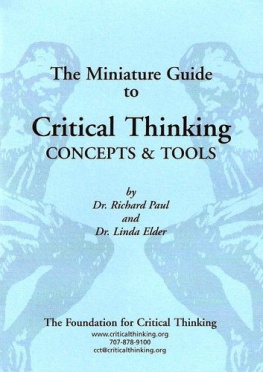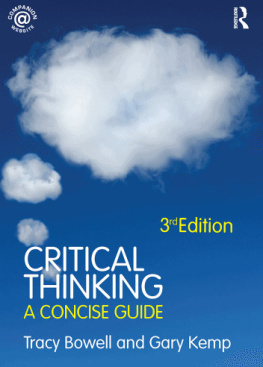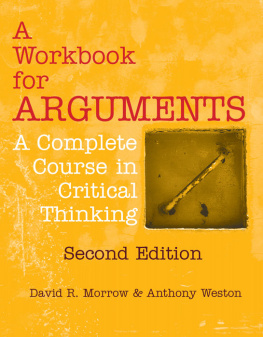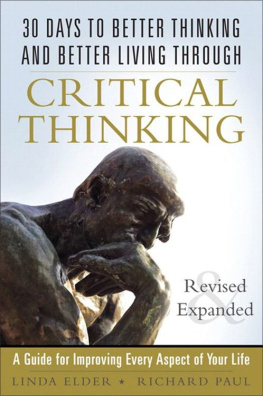
A PRACTICAL GUIDE TO
CRITICAL THINKING
Deciding What to Do and Believe
Second Edition
DAVID A. HUNTER
Department of Philosophy
Ryerson University
Toronto, ON, Canada
Copyright 2014 by John Wiley & Sons, Inc. All rights reserved.
Published by John Wiley & Sons, Inc., Hoboken, New Jersey.
Published simultaneously in Canada.
No part of this publication may be reproduced, stored in a retrieval system, or transmitted in any form or by any means, electronic, mechanical, photocopying, recording, scanning, or otherwise, except as permitted under Section 107 or 108 of the 1976 United States Copyright Act, without either the prior written permission of the Publisher, or authorization through payment of the appropriate per-copy fee to the Copyright Clearance Center, Inc., 222 Rosewood Drive, Danvers, MA 01923, (978) 750-8400, fax (978) 750-4470, or on the web at www.copyright.com. Requests to the Publisher for permission should be addressed to the Permissions Department, John Wiley & Sons, Inc., 111 River Street, Hoboken, NJ 07030, (201) 748-6011, fax (201) 748-6008, or online at http://www.wiley.com/go/permission.
Limit of Liability/Disclaimer of Warranty: While the publisher and author have used their best efforts in preparing this book, they make no representations or warranties with respect to the accuracy or completeness of the contents of this book and specifically disclaim any implied warranties of merchantability or fitness for a particular purpose. No warranty may be created or extended by sales representatives or written sales materials. The advice and strategies contained herein may not be suitable for your situation. You should consult with a professional where appropriate. Neither the publisher nor author shall be liable for any loss of profit or any other commercial damages, including but not limited to special, incidental, consequential, or other damages.
For general information on our other products and services or for technical support, please contact our Customer Care Department within the United States at (800) 762-2974, outside the United States at (317) 572-3993 or fax (317) 572-4002.
Wiley also publishes its books in a variety of electronic formats. Some content that appears in print may not be available in electronic formats. For more information about Wiley products, visit our web site at www.wiley.com.
Library of Congress Cataloging-in-Publication Data:
Hunter, David A., 1965 author.
A practical guide to critical thinking : deciding what to do and believe / David A. Hunter, Department of Philosophy, Ryerson University. Second edition.
pages cm
Includes bibliographical references and index.
ISBN 978-1-118-58308-1 (cloth)
1. Critical thinking. I. Title.
BF441.H86 2014
121dc23
2014012671
For Jane,
my beloved and my friend.
PREFACE
In preparing this Second Edition, I have benefited from many people's advice. First, I would like to thank all of the students at Ryerson University who have taken my critical thinking courses, and all of the graduate students who have worked for me as a TA. I have learned a lot from you all about how to organize, simplify, and present this material. I have also benefited from detailed and constructive comments on every chapter from my colleague, Klaas Kraay.
PREFACE TO FIRST EDITION
This book has been a long time in the making, and has benefited from the influence of a huge number of colleagues, friends, and family. Here is an inevitably incomplete accounting of some of these debts.
I first began to think systematically about the nature, value, and pedagogy of critical thinking as an assistant professor of philosophy at Buffalo State College and it would be difficult to overstate the influence of my colleague George Hole on my thinking. He is one of the most gifted philosophy teachers I have ever known and I learned a good deal from him on how to teach philosophy. But even more than this, I am indebted to him for the way he so easily mixes philosophy, wit, and good humor in equal parts. I learned more from him than from anyone about how to teach critical thinking, and about the central role it ought to play in education and in a full life. I also owe a great deal to Gerry Nosich, whose work on critical thinking is without equal. Gerry joined us at Buffalo State College as we were designing and implementing a required first-year critical thinking course, and his gentle and wise advice proved invaluable. While with SUNY, I worked on a statewide committee to design a rubric for the assessment of critical thinking. I learned a lot in this time about the importance of teaching critical thinking across the curriculum, and I am especially indebted to Shir Filler.
Since beginning the writing of this book, I have learned a good deal from my new colleagues at Ryerson University, where the philosophy department teaches several sections of a critical thinking course that is required by students in several programs. I owe special debts to Andrew Hunter, Klaas Kraay, David Ciavatta, Jim Dianda, and Paul Raymont.
I am indebted to Steve Quigley, my editor at Wiley, for gently persuading me to write the book; to Jackie Palmieri, an editorial assistant at Wiley, for gently persuading me to complete it on time; and to several anonymous referees who provided useful feedback on my initial proposal.
I am enormously indebted to my family. I learned as much about how to think critically from my parents as from anyone. They showed me that critical thinking begins at home, and that is a lesson that Miranda and Emily, my wonderful daughters, now champion with exhausting ingenuity.
My greatest and deepest debts, however, are to Jane, whose love and support have never been conditional on sufficient and acceptable reasons or on anything else.
NOTE TO INSTRUCTORS
Teaching students to think critically is more about imparting a set of skills and habits than about teaching bits of theory. In developing this textbook, I tried to incorporate several features that I thought would make teaching critical thinking both easier and more effective.
Most significantly, I steered clear of any formal notation aside from the very simplest. It is not that I doubt the value of learning formal logic. In fact, I think that many students thrive while studying it. But in my experience there is so much that most students need to learn before they can see the value of mastering a formal system, and so much more benefit they can derive from a non-formal approach to critical thinking. Instead, I tried to think of this text as like an introduction to practical or applied epistemology: offering systematic advice, and lots of practice, on the best way to go about deciding what to believe and what to do.
It is worth noting here that I treat what is sometimes called enumerative induction as a form of reasoning by analogy. It seems to me that using samples to draw a conclusion about an entire group or population just is reasoning by analogy, and that it can be usefully taught as such. I also say, and this perhaps is more controversial, that reasoning by analogy can be valid. Of course, I do not mean that it is formally valid in the way that modus ponens is formally valid. Reasoning is valid when it is not possible for the premises to be true and the conclusion to be false. The fact that some reasoning can be known to be valid just from its form alone is, of course, important, and I discuss some of these forms in chapters 5 and 6. But it is important to keep in mind that not all valid arguments are formally valid, (e.g., The table is blue, therefore it is colored), and not all arguments that are formally invalid are really invalid (e.g., If Jones is a male, then he is a bachelor; Jones is a bachelor; so, Jones is a male.) Judgment is always needed, it seems to me, in assessing the strength of a piece of reasoning, and this judgment is better taught by focusing on the idea of validity itself. I also think that what I say in Chapter 6 makes a reasonable and pedagogically responsible case for my view that reasoning by analogy can be valid.
Next page
